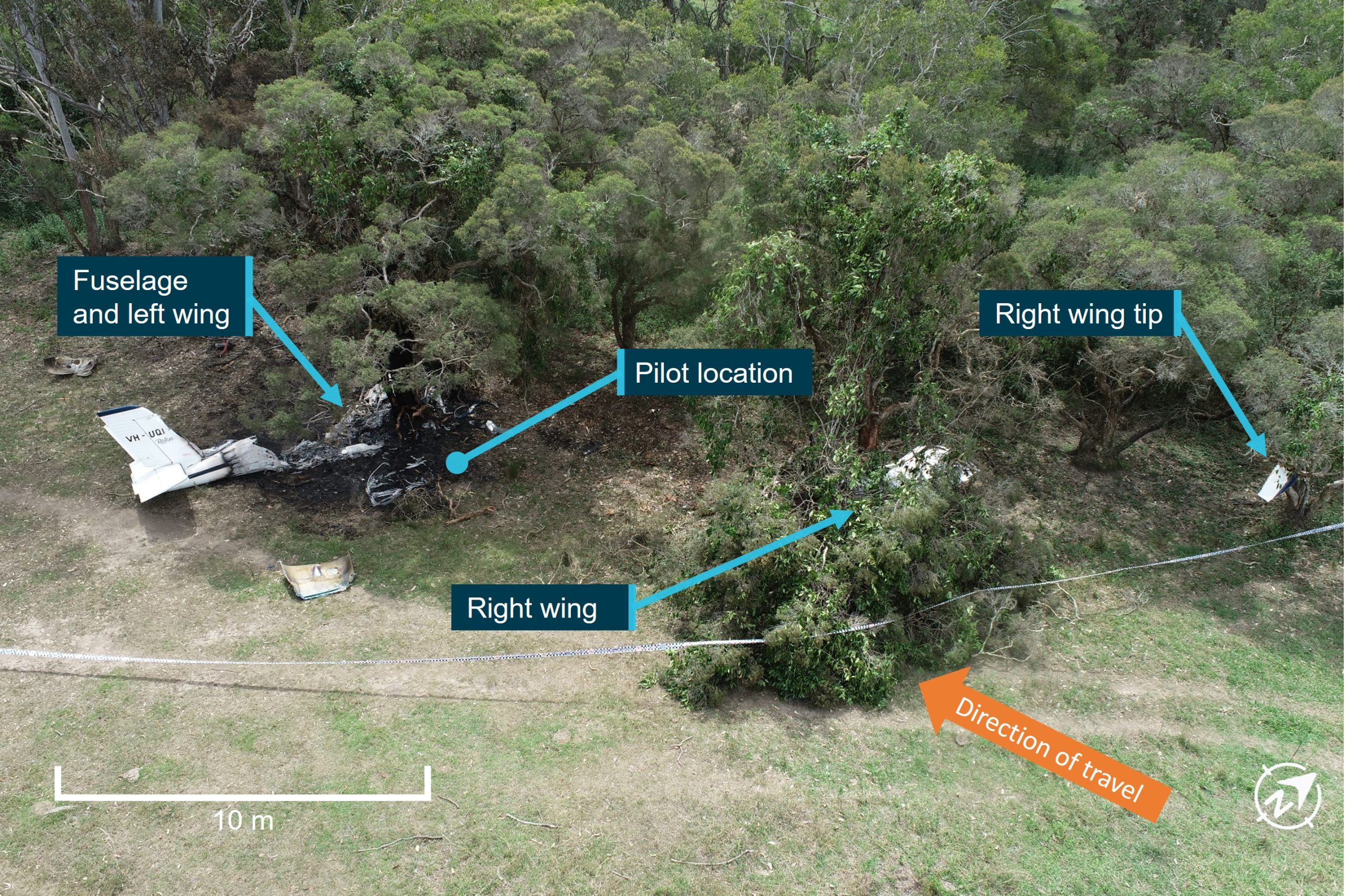Should it have been a surprise when an aircraft engine that had not been overhauled for 23 years exploded, sprayed oil over the windscreen and led to a crash that seriously injured the pilot?
Morane-Saulnier MS.893A Rallye, 22 km south-west of Archerfield Airport, Qld, 6 November 2020
With a combination of imagination and analysis, it’s possible to see in the mind’s eye how an accident results from multiple factors, accumulating in the now-familiar ‘Swiss cheese’ theory promulgated by James Reason.
It’s as if the sky is filled with invisible holes that come into being, grow, then burst, like giant malignant soap bubbles. Occasionally, through a combination of human and technical shortcomings, an unfortunate aircraft flies through enough of these conceptual holes to put its safety at serious risk. Equally sobering is the thought that every aircraft possibly encounters at least one Swiss cheese hole per flight.
The Australian Transport Safety Bureau (ATSB) investigation acknowledged the Swiss cheese pattern in its investigation. The pilot had planned a familiarisation flight with an instructor but arrived at the aerodrome late in the day after the instructor had left. The pilot took the aircraft up for an 18-minute flight but later said they were not aware of the aircraft’s performance characteristics.
This was a missed opportunity because the performance characteristics of this aircraft, a French-made Morane-Saulnier MS.893A Rallye, were in some respects outstanding. The Rallye is a low-wing, four-seater monoplane, powered by a Lycoming O-360 four-cylinder piston engine driving a Hartzell two-blade constant-speed propellor. A combination of full-span slats and large Fowler flaps provide a slow-speed flight performance that facilitates short field take-off and landing. The flight manual shows the landing distance in nil wind at 26° C, with full flaps, was about 160 m at full gross weight and 125 m at 750 kg.
Knowing the aircraft’s slow-speed characteristics may have helped with the forced landing, the ATSB said in its accident report.
New and old
The pilot had obtained a PPL 3 months before the accident and had 99 flying hours by the day of the accident. The pilot was ferrying the aircraft on behalf of the owner from Moruya, NSW to Archerfield, Qld. The aircraft had been stored at the coastal town’s airport for about 7 years and was being sold due to little use. The engine was last overhauled in 1997 and had run for 324 hours since then. Lycoming’s service schedule calls for an overhaul in 12 years or 2,000 hours, whichever came first.
Although the engine had exceeded the calendar schedule of the manufacturer’s time between overhaul, this was permissible when the engine was maintained in accordance with CASA’s on-condition requirements. At the last annual inspection in May 2020, the maintenance organisation had completed a piston engine condition report, verifying the engine serviceability, which then permitted the engine to continue in service.
Known risks addressed
As behoves a wise novice, the pilot had discussed the proposed flight with an instructor and decided to take an inland route, rather than along the coast, to avoid controlled airspace and fly at a higher altitude.
The pilot was unfamiliar with the Archerfield area and Class D operations and said later they had increased ‘nervousness’ due to lack of experience with operating in controlled airspace.
The flight
Around 8 am on 6 November 2020, the aircraft departed Moruya and flew to Bathurst for refuelling. The pilot then tracked towards Gilgandra before changing course to Gunnedah to avoid a military flying area. After refuelling, the aircraft departed on the final leg.
About 32 km south-west of Archerfield, while flying at 2,000 feet, the pilot made an inbound call to Archerfield tower requesting airways clearance; however, this call was made on the Brisbane Approach frequency. The report makes no comment about fatigue leading to mistakes.
The Approach controller told the pilot they were on the incorrect frequency but this was not acknowledged. About 90 seconds later, the pilot broadcast a MAYDAY, again on the Approach frequency, citing ‘total engine failure’.
The aircraft was approaching built-up areas, with few suitable forced landing areas. And the pilot’s forward view was obscured by oil on the windscreen and thick smoke. As the drama unfolded, the pilot made a right turn towards an open paddock but later had no recollection of the wind direction from the Archerfield AWIS. The final approach was to the south-west – downwind. The aircraft touched down about two-thirds into the paddock, bounced, hit trees and burst into flames.
The pilot was thrown from the aircraft and was unconscious but was moved by witnesses to safety before the aircraft was destroyed by fire.
Metallic matters
Before 1995 Lycoming O-360 engines used copper-lead alloy connecting rod journal bearings. These were replaced by aluminium-tin alloy bearings, which were available between 1995 to 2001 (corresponding with the time of the last engine overhaul in 1997). These were then superseded in September 2004 by Lycoming Service Instruction No. 1512. The aluminium-tin bearings were required to be replaced with the upgraded bearings (copper-lead alloy) whenever new bearings were to be installed (such as at engine overhaul).
This accident highlights the need for owners and maintainers to be cognisant of the manufacturer’s service information.
ATSB research
In 2007, the ATSB published a research and analysis report into aircraft reciprocating (piston) engine failures. The report examines 20 high-power piston engine structural failure occurrences in Australia, between 2000 and 2005. The report focused on failures of the combustion chamber, connecting rods and crankshaft assemblies.
The failures of engine crankshafts could be linked to failure of the bearings, both crankshaft main bearings and the connecting rod (big end) bearings. The report found an increasing trend (for the period 1993–2003) that bearings composed with an aluminium-tin alloy would separate from the steel backing material. The same separation was not observed on bearings with a copper-lead alloy.
The ATSB research report noted CASA Airworthiness Bulletin AWB 85-001 Issue 4 (April 2006), Textron Lycoming engine bearings, also stated the aluminium-tin bearings had a high failure rate and were therefore being replaced with the original copper-tin bearings. Nothing of the sort was done to the engine of the accident aircraft. In this sense it flew through a Swiss cheese hole, while still in the hangar.
Missing the memo
ATSB Director Transport Safety Dr Stuart Godley said the investigation found the separation of the number 2 piston connecting rod initiated a catastrophic mechanical failure of the engine.
The engine had not been overhauled since 1997, and had had limited usage for an extended period, possibly with no specific engine preservation done while in storage.
‘Had the engine been overhauled at the manufacturer’s recommended calendar time, the connecting rod journal bearings would have been replaced with post-modification bearings,’ Godley said.
‘This accident highlights the need for owners and maintainers to be cognisant of the manufacturer’s service information, to ensure the serviceability of engine and airframe systems are maintained to the highest standards.’
The investigation also found the aircraft was not fitted with a fixed or portable emergency locator transmitter and the pilot did not leave a flight note with a responsible person.
Engine examination
The engine was disassembled and inspected under the supervision of the ATSB. The examination revealed that all components were heat affected from the post-impact fire. The crankcase had large holes either side of the number 2 cylinder and a series of adjacent impact marks on the internal surface. The number 2 connecting rod was fractured and separated from the crankshaft journal and piston. The connecting rod fracture surfaces were significantly damaged, which precluded any meaningful materials failure analysis.
Reflections
CASA Aviation Safety Advisor Terry Horsam said it was reassuring the pilot survived this crash.
‘I am sure they have some important reflections on their preparation for this flight,’ he said.
‘As aviation safety advisors, we often talk about ‘safety beyond compliance’ and although technically this flight was compliant, many pilots would question the decision to operate this aircraft after such a long period of inactivity. It is a warning to all that the cowling can hide a plethora of surprises, particularly if recommended maintenance is neglected.
‘The pilot also had a Single Engine Aeroplane class rating that allowed them to fly the Rallye; however, as the pilot had not operated this type before, CASA’s general competency rule 61.385 applied. This rule requires pilots to be conversant with aircraft systems, performance and limitations and, as such, they would have been made aware of the differences pursuant to this type, including its low-speed handling characteristics.
‘This pilot had good intentions in discussing the proposed flight with an instructor which is to be commended as instructors are an underutilised resource once we get our licence. It is often quoted that for every hour of a flight, particularly when newly qualified, we should spend 2 hours planning.
‘By being unprepared for the flight into Archerfield, the pilot’s workload was already high, which placed them at a distinct disadvantage when the engine failed.’






Comments are closed.